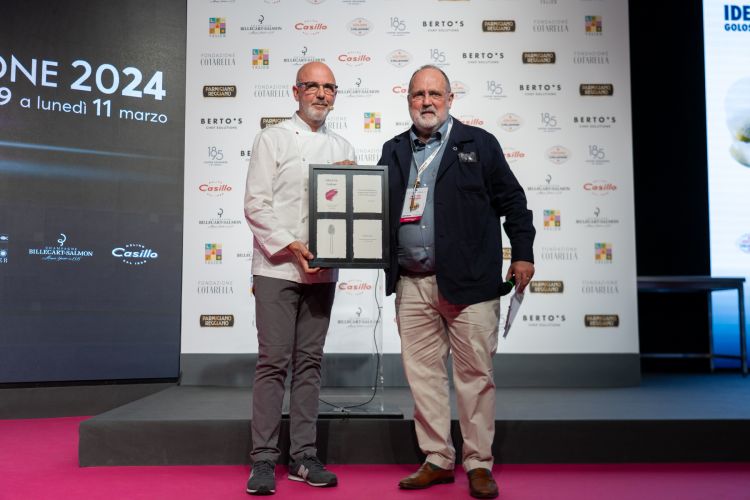Let's face it: at the end of this chronicle, we will discover that Franco Pepe can make pizza even without a real oven. What’s more disobedient than that!
In a packed Auditorium hall, the Caserta-based pizza maker experienced Identità Milano for the 13th time, as Paolo Marchi, who introduced him in the masterclass, recalled.
Pepe begins: ‘I would like to focus on my very personal disobedience, starting from some external input.’ The definition of 'disobedience' according to the Treccani dictionary appears on screen, followed by a contribution by Paolo Crepet, a well-known psychiatrist and writer, who recounts how, in the 1950s, wearing a blue shirt instead of the standard white shirt (which, combined with monochrome clothes, made everything look sad and grey in the photos of the time), helped John Fitzgerald Kennedy win the elections. There is also a quote from Don Lorenzo Milani: 'To disobey is a virtue'. Transposed to our days we can read it as: teach children not to do everything the Internet wants. ‘In these concepts I see my Margherita Sbagliata. There have been disobedient acts in my life, resulting from my need for a path of personal growth,' Pepe confesses and he starts to rattle off a series of headwords on the disobediences that have marked his existence, almost turning into a living, human dictionary.
Disobedience as detachment from the family: ‘I wanted to question myself, after acquiring knowledge through my father and following the same path as my brothers: I needed to create my own identity,’ which is why the master from Caiazzo decided to invest everything in what was to become Pepe in Grani, driven by the sheer force of his own ideas. ‘I didn't want to hurt or upset anyone: I just wanted to create a small path. My own.’ Pepe in Grani is an always-evolving project, a new concept of pizzeria, with tasting rooms, the Authentica experience, guest rooms, but always with an offer suitable for everyone (today it has close to 12,000 guests per month). This leads to ‘disobedience towards Neapolitan pizza.’
Indeed, Pepe continues: ‘Around fifteen years ago, there was a lot of attention towards the world of pizza, even from fine dining. I felt I had to gather this ferment and translate it into a pizza of my own, with its own identity, without labels.’ As a consequence, in 2017, the
Associazione Verace Pizza Napoletana even claimed he was an 'apostate', just because he had declared - on Netflix's
Ugly Delicious series - that for him there is no such thing as DOC or PDO pizza, only good pizza.
In fact, this episode causes visits to Caiazzo to rocket, especially from the USA, giving Pepe the courage to reach 'disobedience in pizzas'. This led to the birth of Margherita Sbagliata to express the curly tomato at its best, with hot-cold contrasts; of Ananascosta (the result of a study on pineapple, to understand the ingredient without demonising it a priori, and without considering it a mediatic act); and of Acquerello Capriccioso (an evolution of pizza Capricciosa, finished at the table by the customer, with ingredients prepared separately in the kitchen in the right way and not cooked all together in the oven).
Franco Pepe gets serious and points out: ‘Pizza thus becomes a thought-out concept, a creative product: it requires attention, starting from the choice of the ingredients to their processing. Today, in my opinion, pizza is considered more form than substance. Everyone takes pictures of pizzas: but a beautiful pizza is not necessarily healthy, digestible and sustainable. We must be very careful with communication: we are bombarded with input from social media, bloggers, influencers and so on. But if you waste time like this [taking pictures], you risk undoing the work: for example, the hot-cold contrast of Margherita Sbagliata may disappear, nullifying all the preparation behind it. Take pictures with your palate: this will be a lasting emotion!’

He continues with what will be his penultimate act of disobedience: ‘A lot of old people still come to see me and remember when, as a child, I used to serve them pizza, while helping out in my father's pizzeria. They would queue up to get into Stefano Pepe's, but nobody ever mentioned my father on social media, because they didn't exist yet. So how did he have a queue of people waiting? Thanks to what he served for the customers’ palate, putting good and fair things on the plate. Today the disobedience reverts to valuing the approach to the palate.’
In this climax of personal disobedience, the last stimulus appears: the photo of a very small, chimney-less refractory brick oven, found in the ruin that later became Pepe in Grani. But what was it used for? Researching the history of that building, they learnt that priests used to live there and made the wafers for mass with that very tiny oven. Enraptured by that object and its old use, as a legacy of the message shared from the stage, Franco Pepe decided to make wafers. He presents them in a paper bag. They’re very thin and bright red: when tasting them, they express the flavours of pizza a libretto, an emblem of popular food that must always remain so.
We come to the final disobedience: the absence of pizza becoming essence.
Once again, we can only learn from Franco Pepe.
Translated into English by Slawka G. Scarso